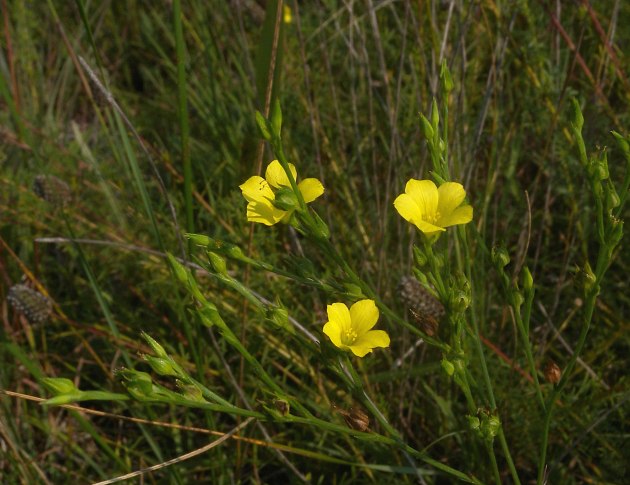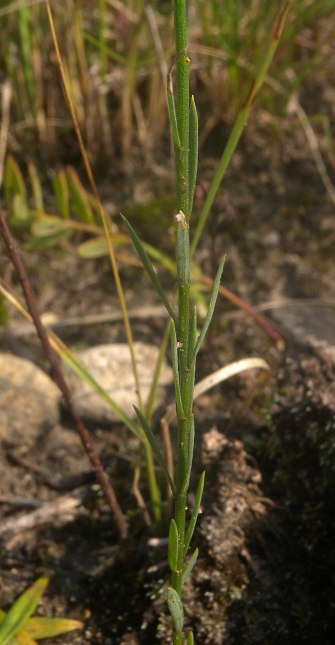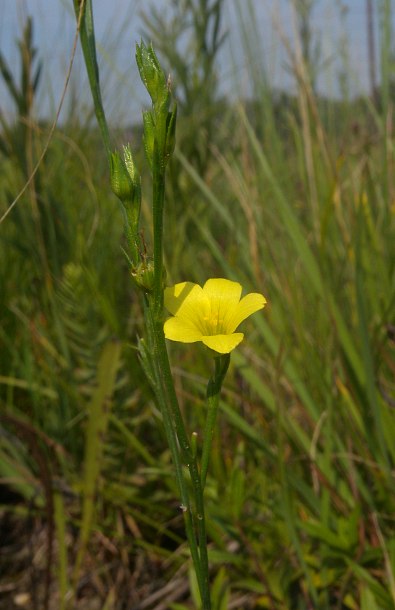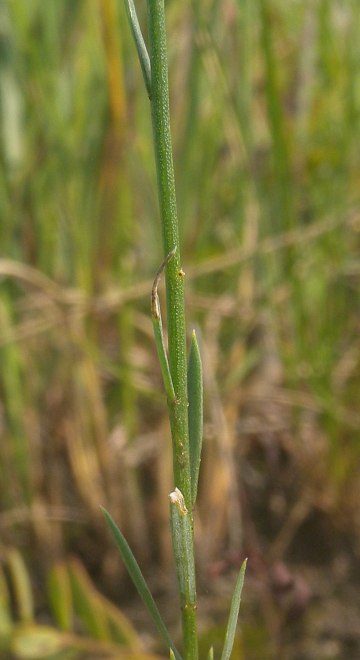
Individual flowers occur at the tips of the pedicels; usually only one or a few flowers bloom at the same time. Each flower is about ½" (13 mm.) across and ½" (13 mm.) long, consisting of 5 yellow petals, 5 green sepals, 5 stamens with yellow anthers, and an ovary with 5 styles that are joined together below. The petals are oblanceolate or obovate in shape with several fine translucent veins that originate from the throat of the flower; the petals are strongly ascending below and widely spreading above when they are fully open. The sepals are lanceolate in shape with hair-like glandular teeth along their margins; each sepal has a pale green longitudinal band in the middle and narrow pale green margins, otherwise it is medium green. The sepals are about one-third as long as the petals. The blooming period occurs during the summer for 1-2 months. Each flower remains in bloom for a single day, after which the petals fall off. The flowers are replaced by ovoid-globoid seed capsules that become dark brown at maturity; these capsules are surrounded by the persistant sepals. Individuals capsules split open later in the year into 10 sections to release their seeds (there is a single seed per section). The seeds are about 1.5–2 mm. long, reddish brown, ellipsoid in shape, and somewhat flattened. The root system consists of a slender taproot with secondary fibrous roots. This plant spreads by reseeding itself.

Cultivation: The preference is full sun, dry conditions, and a barren soil containing gravelly clay or sand. Plants that are spoiled with fertile soil and too much water may topple over as they mature.
Range & Habitat: In Illinois, the native Grooved Yellow Flax (Linum sulcatum) occurs primarily in northern and western Illinois, where it is uncommon, while in the rest of the state it is rare or absent (see Distribution Map). This plant occurs primarily in the Midwestern area of the United States, although widely scattered populations also occur further to the east and southeast. Habitats include gravel hill prairies, gravel prairies, gravelly slopes along rivers, loess hill prairies, sandy hill prairies, upland sand prairies, and limestone glades. Depending on the time of year, occasional wildfires can be beneficial in maintaining populations of this species. Grooved Yellow Flax occurs in high quality natural areas.

Faunal Associations: The flowers attract bumblebees, long-horned bees (Melissodes spp.), and metallic wood-boring beetles (Acmaeodera spp.); see Smith et al. (2012) and MacRae (1991) for more information. These insects probably feed on nectar and/or pollen. Like many other Flax species (Linum spp.), the foliage and seeds of Grooved Yellow Flax (Linum sulcatum) contain toxic cyanogenic compounds that deter their consumption by herbivores. Sheep are thought to be especially susceptible to these toxic compounds (Ninnescah Life, 2017).
Photographic Location: A gravel hill prairie at Lake in the Hills Fen Nature Preserve in McHenry County, Illinois.

Comments: Grooved Yellow Flax (Linum sulcatum) is the only native Flax (Linum) in Illinois that is an annual; other species are perennials. Unlike the blue-flowered Flax species that are not native to the state, all of the native Flax species have yellow flowers and they are similar in appearance. Grooved Yellow Flax can be distinguished by the pair of glandular brown dots that appear at the base of most leaves; other native species of Flax lack them. Similarly, the stems of this species have shallow longitudinal grooves that are separated by narrow ridges with minute whitish hairs; other native Flax species have simple terete stems. In addition, the sepals of the flowers of Grooved Yellow Flax have hair-like glandular teeth along their margins, while the sepals of other native species of Flax are toothless. The sepals of Grooved Yellow Flax also persist around the seed capsules, even when the latter are mature. In contrast, the sepals of other native Flax species fall from the flowers before their seed capsules become mature. Grooved Yellow Flax also prefers dry barren habitats, such as gravel hill prairies and sandy hill prairies, to a greater extent than other native Flax species.